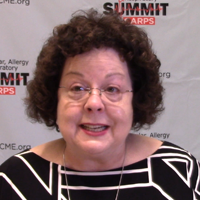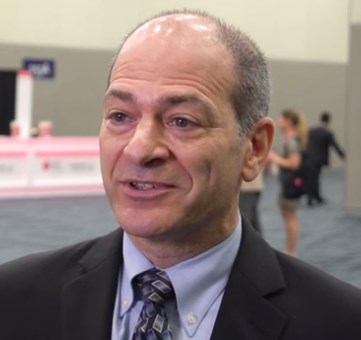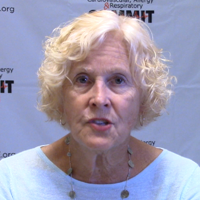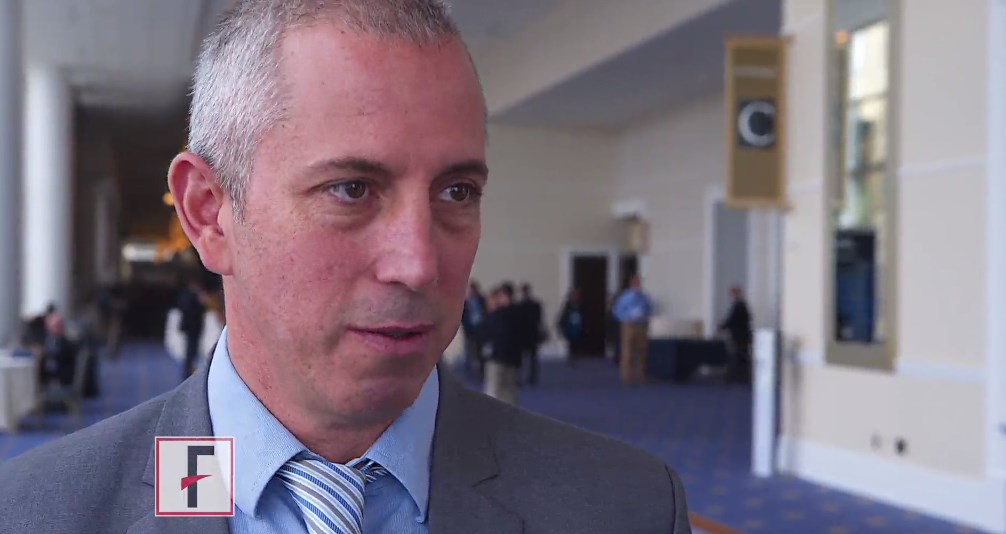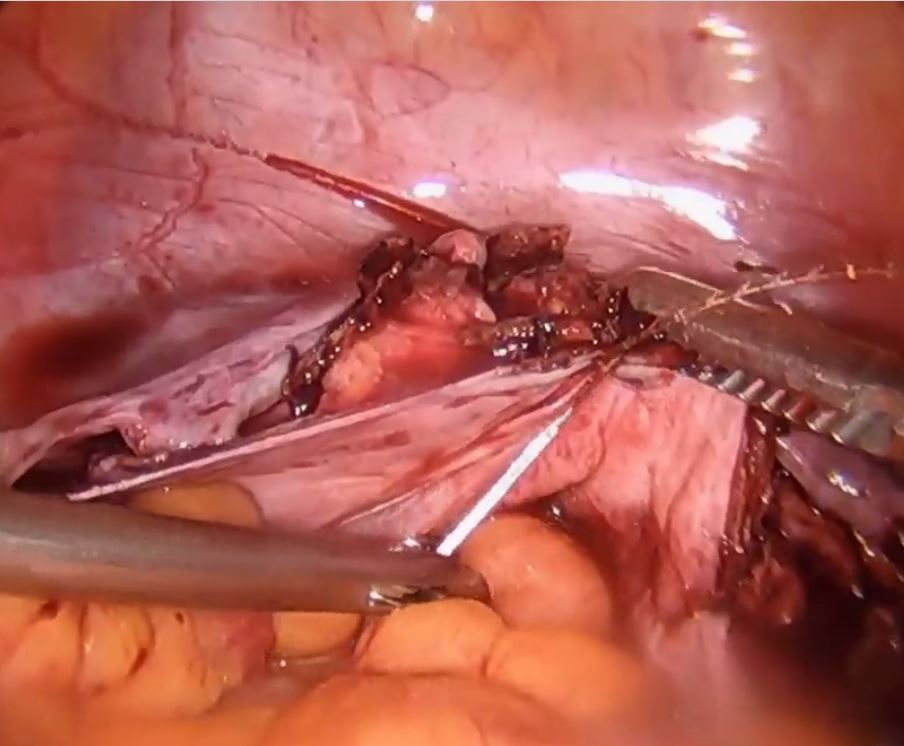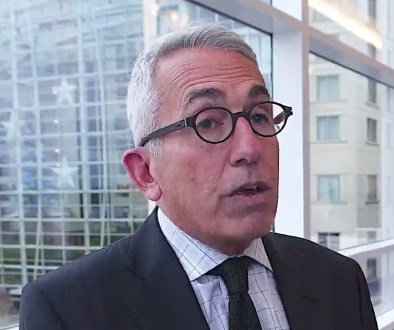User login
Acute Bronchitis
The video associated with this article is no longer available on this site. Please view all of our videos on the MDedge YouTube channel
The video associated with this article is no longer available on this site. Please view all of our videos on the MDedge YouTube channel
The video associated with this article is no longer available on this site. Please view all of our videos on the MDedge YouTube channel
VIDEO: Canakinumab’s cardiovascular benefits linked with hsCRP cuts
ANAHEIM, CALIF. – Targeting the anti-inflammatory drug canakinumab to cardiovascular disease patients with a robust response to a single dose may be an effective way to enhance the cost benefit of this novel treatment that is effective but also expensive.
A post hoc analysis of data collected in the ground-breaking CANTOS trial showed that among patients with a robust anti-inflammatory response to their first dose of canakinumab, the 4-year rate of major adverse cardiovascular events fell by 25% compared with patients who received placebo, a much higher relative risk reduction compared with all canakinumab recipients in the study. In this responsive subgroup, which constituted 55% of all patients assessed after their first dose, canakinumab also cut both cardiovascular death and all-cause death by 31% each relative to placebo, statistically significant reductions that had not been seen in the trial’s primary analysis that included all drug recipients, Paul M. Ridker, MD, said at the American Heart Association scientific sessions.
“The current analysis suggests that the magnitude of hsCRP [high sensitivity C-reactive protein] reduction following a single dose of canakinumab may provide a simple clinical method to identify individuals most likely to accrue the largest cardiovascular and cancer benefits from continued treatment.” The findings have importance “for patient selection, cost-effectiveness, and personalized medicine” as researchers and clinicians begin using anti-inflammatory drugs such as canakinumab to treat cardiovascular disease patients, said Dr. Ridker, professor of medicine at Harvard Medical School and director of the Center for Cardiovascular Disease Prevention at Brigham and Women’s Hospital, both in Boston.
“The magnitude of the hsCRP reduction” after the first dose “is telling us who benefits most,” Dr. Ridker said in a video interview.
The Canakinumab Anti-inflammatory Thrombosis Outcome Study (CANTOS) enrolled patients with a history of a MI and a “residual” inflammatory risk based on having an hsCRP level above 2 mg/L at baseline despite receiving optimized standard treatments and having a median LDL cholesterol level of 82 mg/dL. Dr. Ridker and his associates reported the study’s primary outcome results in August at the European Society of Cardiology meeting and in a simultaneously-published article (N Engl J Med. 2017 Sept 21; 377[12]:1119-31).
For the current analyses they defined a robust anti-inflammatory response as CANTOS patients who maintained an hsCRP level below 2 mg/L when measured 3 months after their first canakinumab dose. When the researchers divided all canakinumab recipients into tertiles based on their achieved hsCRP level after one dose, those with the lowest level, less than 1.2 mg/L, also had the best outcome, with a 4-year rate of major adverse cardiovascular events that was 29% lower than the placebo patients. Patients in the middle tertile of achieved hsCRP, from 1.2 up to but not including 2.6 mg/L, showed a smaller but still statistically significant relative 17% reduction in events, while patients with the tertile with the highest hsCRP levels following one canakinumab dose had essentially no difference in their outcomes compared with placebo-treated control patients.
These findings suggest that for hsCRP, “lower is better,” Dr. Ridker noted. “It’s similar to where we were in 1994” when trial results showed how LDL levels related to cardiovascular disease events and the potential that statin treatment held had for reducing event rates.
The new analyses included three additional notable findings:
• The main serious adverse effect from canakinumab treatment, fatal infections, which occurred at a small but significantly higher rate than in control patients, had a similar incidence of about one episode/300 patient years regardless of whether the achieved hsCRP level fell below 2 mg/L or remained above that level. The placebo rate of fatal infections was about one for every 500 patient years.
• The substantially reduced incidence of lung cancer seen in the primary CANTOS results also tracked with achieved hsCRP. Patients with an achieved hsCRP that was below the median for all treated patients had a 71% cut in new-onset lung cancer compared with controls, while patients with hsCRP levels that fell above the median showed no significant difference compared with control patients.
• All three doses of canakinumab tested in CANTOS – 50 mg, 150 mg, and 300 mg administered by subcutaneous injection once every 3 months – produced a drop in hsCRP to below 2 mg/L in some patients, but the rate at which patients reached this level differed depending on dose: 44% among patients who received the lowest dose, 55% of those who received a 150-mg dose, and 65% among those on the highest dose.
But this “responder analysis” of patients who received canakinumab received a strong cautionary caveat from Robert M. Califf, MD, professor of medicine and vice chancellor for health data sciences at Duke University in Durham, N.C.
“Beware of responder analyses,” Dr. Califf said during a talk at the meeting in which he commented on the new CANTOS findings. “There is a long history in cardiology of being misled” by responder analyses, he said.
Dr. Ridker added that the mechanism that determines whether patients have a robust or modest response to canakinumab remains unclear, although it likely depends on genetic factors. He also noted that research being done by himself and others is investigating the efficacy of other anti-inflammatory drugs that could potentially cut cardiovascular disease rates, including methotrexate and colchicine.
Canakinumab (Ilaris) had Food and Drug Administration marketing approval to treat systemic juvenile idiopathic arthritis and pediatric fever syndromes. Concurrently with the meeting report, the results appeared in an article online (Lancet 2017 Nov 13. doi: 10.1016/S0140-6736[17]32814-3).
CANTOS was sponsored by Novartis, the company that markets canakinumab. Dr. Ridker has been a consultant to Novartis and was lead investigator of CANTOS. He also holds patents on using hsCRP to assess cardiovascular disease risk. Dr. Califf is an adviser to Verily Health Sciences.
mzoler@frontlinemedcom.com
On Twitter @mitchelzoler
CANTOS is a landmark trial for showing the importance of inflammation in causing cardiovascular disease events. The new analyses from CANTOS strengthen the biological premise of the study and better address some concerns about the magnitude of benefit raised following the first report of the CANTOS findings. We now see an increased effect on major cardiovascular disease events and, for the first time, an impact from treatment on cardiovascular death and all-cause death in the subgroup of patients with a robust anti-inflammatory response to the drug. This shows the possibility of an enhanced benefit-to-risk balance by focusing canakinumab treatment on responsive patients.
New anti-inflammatory agents now in development offer the prospect for oral drugs that could have similar benefits, and by targeting such treatments to selected patients we can envision using an anti-inflammatory strategy for primary prevention of cardiovascular disease events as well as for secondary prevention. We can also anticipate studies that will show how to better integrate anti-inflammatory interventions with lipid-lowering drugs, as well as selected drugs used to treat diabetes.
The data from CANTOS has opened a new world of possibilities related to anti-inflammatory treatments for preventing and treating cardiovascular diseases.
Ira Tabas, MD , is professor of medicine, cell biology, and physiology at Columbia University in New York. He had no disclosures. He made these comments as designated discussant for Dr. Ridker’s report.
CANTOS is a landmark trial for showing the importance of inflammation in causing cardiovascular disease events. The new analyses from CANTOS strengthen the biological premise of the study and better address some concerns about the magnitude of benefit raised following the first report of the CANTOS findings. We now see an increased effect on major cardiovascular disease events and, for the first time, an impact from treatment on cardiovascular death and all-cause death in the subgroup of patients with a robust anti-inflammatory response to the drug. This shows the possibility of an enhanced benefit-to-risk balance by focusing canakinumab treatment on responsive patients.
New anti-inflammatory agents now in development offer the prospect for oral drugs that could have similar benefits, and by targeting such treatments to selected patients we can envision using an anti-inflammatory strategy for primary prevention of cardiovascular disease events as well as for secondary prevention. We can also anticipate studies that will show how to better integrate anti-inflammatory interventions with lipid-lowering drugs, as well as selected drugs used to treat diabetes.
The data from CANTOS has opened a new world of possibilities related to anti-inflammatory treatments for preventing and treating cardiovascular diseases.
Ira Tabas, MD , is professor of medicine, cell biology, and physiology at Columbia University in New York. He had no disclosures. He made these comments as designated discussant for Dr. Ridker’s report.
CANTOS is a landmark trial for showing the importance of inflammation in causing cardiovascular disease events. The new analyses from CANTOS strengthen the biological premise of the study and better address some concerns about the magnitude of benefit raised following the first report of the CANTOS findings. We now see an increased effect on major cardiovascular disease events and, for the first time, an impact from treatment on cardiovascular death and all-cause death in the subgroup of patients with a robust anti-inflammatory response to the drug. This shows the possibility of an enhanced benefit-to-risk balance by focusing canakinumab treatment on responsive patients.
New anti-inflammatory agents now in development offer the prospect for oral drugs that could have similar benefits, and by targeting such treatments to selected patients we can envision using an anti-inflammatory strategy for primary prevention of cardiovascular disease events as well as for secondary prevention. We can also anticipate studies that will show how to better integrate anti-inflammatory interventions with lipid-lowering drugs, as well as selected drugs used to treat diabetes.
The data from CANTOS has opened a new world of possibilities related to anti-inflammatory treatments for preventing and treating cardiovascular diseases.
Ira Tabas, MD , is professor of medicine, cell biology, and physiology at Columbia University in New York. He had no disclosures. He made these comments as designated discussant for Dr. Ridker’s report.
ANAHEIM, CALIF. – Targeting the anti-inflammatory drug canakinumab to cardiovascular disease patients with a robust response to a single dose may be an effective way to enhance the cost benefit of this novel treatment that is effective but also expensive.
A post hoc analysis of data collected in the ground-breaking CANTOS trial showed that among patients with a robust anti-inflammatory response to their first dose of canakinumab, the 4-year rate of major adverse cardiovascular events fell by 25% compared with patients who received placebo, a much higher relative risk reduction compared with all canakinumab recipients in the study. In this responsive subgroup, which constituted 55% of all patients assessed after their first dose, canakinumab also cut both cardiovascular death and all-cause death by 31% each relative to placebo, statistically significant reductions that had not been seen in the trial’s primary analysis that included all drug recipients, Paul M. Ridker, MD, said at the American Heart Association scientific sessions.
“The current analysis suggests that the magnitude of hsCRP [high sensitivity C-reactive protein] reduction following a single dose of canakinumab may provide a simple clinical method to identify individuals most likely to accrue the largest cardiovascular and cancer benefits from continued treatment.” The findings have importance “for patient selection, cost-effectiveness, and personalized medicine” as researchers and clinicians begin using anti-inflammatory drugs such as canakinumab to treat cardiovascular disease patients, said Dr. Ridker, professor of medicine at Harvard Medical School and director of the Center for Cardiovascular Disease Prevention at Brigham and Women’s Hospital, both in Boston.
“The magnitude of the hsCRP reduction” after the first dose “is telling us who benefits most,” Dr. Ridker said in a video interview.
The Canakinumab Anti-inflammatory Thrombosis Outcome Study (CANTOS) enrolled patients with a history of a MI and a “residual” inflammatory risk based on having an hsCRP level above 2 mg/L at baseline despite receiving optimized standard treatments and having a median LDL cholesterol level of 82 mg/dL. Dr. Ridker and his associates reported the study’s primary outcome results in August at the European Society of Cardiology meeting and in a simultaneously-published article (N Engl J Med. 2017 Sept 21; 377[12]:1119-31).
For the current analyses they defined a robust anti-inflammatory response as CANTOS patients who maintained an hsCRP level below 2 mg/L when measured 3 months after their first canakinumab dose. When the researchers divided all canakinumab recipients into tertiles based on their achieved hsCRP level after one dose, those with the lowest level, less than 1.2 mg/L, also had the best outcome, with a 4-year rate of major adverse cardiovascular events that was 29% lower than the placebo patients. Patients in the middle tertile of achieved hsCRP, from 1.2 up to but not including 2.6 mg/L, showed a smaller but still statistically significant relative 17% reduction in events, while patients with the tertile with the highest hsCRP levels following one canakinumab dose had essentially no difference in their outcomes compared with placebo-treated control patients.
These findings suggest that for hsCRP, “lower is better,” Dr. Ridker noted. “It’s similar to where we were in 1994” when trial results showed how LDL levels related to cardiovascular disease events and the potential that statin treatment held had for reducing event rates.
The new analyses included three additional notable findings:
• The main serious adverse effect from canakinumab treatment, fatal infections, which occurred at a small but significantly higher rate than in control patients, had a similar incidence of about one episode/300 patient years regardless of whether the achieved hsCRP level fell below 2 mg/L or remained above that level. The placebo rate of fatal infections was about one for every 500 patient years.
• The substantially reduced incidence of lung cancer seen in the primary CANTOS results also tracked with achieved hsCRP. Patients with an achieved hsCRP that was below the median for all treated patients had a 71% cut in new-onset lung cancer compared with controls, while patients with hsCRP levels that fell above the median showed no significant difference compared with control patients.
• All three doses of canakinumab tested in CANTOS – 50 mg, 150 mg, and 300 mg administered by subcutaneous injection once every 3 months – produced a drop in hsCRP to below 2 mg/L in some patients, but the rate at which patients reached this level differed depending on dose: 44% among patients who received the lowest dose, 55% of those who received a 150-mg dose, and 65% among those on the highest dose.
But this “responder analysis” of patients who received canakinumab received a strong cautionary caveat from Robert M. Califf, MD, professor of medicine and vice chancellor for health data sciences at Duke University in Durham, N.C.
“Beware of responder analyses,” Dr. Califf said during a talk at the meeting in which he commented on the new CANTOS findings. “There is a long history in cardiology of being misled” by responder analyses, he said.
Dr. Ridker added that the mechanism that determines whether patients have a robust or modest response to canakinumab remains unclear, although it likely depends on genetic factors. He also noted that research being done by himself and others is investigating the efficacy of other anti-inflammatory drugs that could potentially cut cardiovascular disease rates, including methotrexate and colchicine.
Canakinumab (Ilaris) had Food and Drug Administration marketing approval to treat systemic juvenile idiopathic arthritis and pediatric fever syndromes. Concurrently with the meeting report, the results appeared in an article online (Lancet 2017 Nov 13. doi: 10.1016/S0140-6736[17]32814-3).
CANTOS was sponsored by Novartis, the company that markets canakinumab. Dr. Ridker has been a consultant to Novartis and was lead investigator of CANTOS. He also holds patents on using hsCRP to assess cardiovascular disease risk. Dr. Califf is an adviser to Verily Health Sciences.
mzoler@frontlinemedcom.com
On Twitter @mitchelzoler
ANAHEIM, CALIF. – Targeting the anti-inflammatory drug canakinumab to cardiovascular disease patients with a robust response to a single dose may be an effective way to enhance the cost benefit of this novel treatment that is effective but also expensive.
A post hoc analysis of data collected in the ground-breaking CANTOS trial showed that among patients with a robust anti-inflammatory response to their first dose of canakinumab, the 4-year rate of major adverse cardiovascular events fell by 25% compared with patients who received placebo, a much higher relative risk reduction compared with all canakinumab recipients in the study. In this responsive subgroup, which constituted 55% of all patients assessed after their first dose, canakinumab also cut both cardiovascular death and all-cause death by 31% each relative to placebo, statistically significant reductions that had not been seen in the trial’s primary analysis that included all drug recipients, Paul M. Ridker, MD, said at the American Heart Association scientific sessions.
“The current analysis suggests that the magnitude of hsCRP [high sensitivity C-reactive protein] reduction following a single dose of canakinumab may provide a simple clinical method to identify individuals most likely to accrue the largest cardiovascular and cancer benefits from continued treatment.” The findings have importance “for patient selection, cost-effectiveness, and personalized medicine” as researchers and clinicians begin using anti-inflammatory drugs such as canakinumab to treat cardiovascular disease patients, said Dr. Ridker, professor of medicine at Harvard Medical School and director of the Center for Cardiovascular Disease Prevention at Brigham and Women’s Hospital, both in Boston.
“The magnitude of the hsCRP reduction” after the first dose “is telling us who benefits most,” Dr. Ridker said in a video interview.
The Canakinumab Anti-inflammatory Thrombosis Outcome Study (CANTOS) enrolled patients with a history of a MI and a “residual” inflammatory risk based on having an hsCRP level above 2 mg/L at baseline despite receiving optimized standard treatments and having a median LDL cholesterol level of 82 mg/dL. Dr. Ridker and his associates reported the study’s primary outcome results in August at the European Society of Cardiology meeting and in a simultaneously-published article (N Engl J Med. 2017 Sept 21; 377[12]:1119-31).
For the current analyses they defined a robust anti-inflammatory response as CANTOS patients who maintained an hsCRP level below 2 mg/L when measured 3 months after their first canakinumab dose. When the researchers divided all canakinumab recipients into tertiles based on their achieved hsCRP level after one dose, those with the lowest level, less than 1.2 mg/L, also had the best outcome, with a 4-year rate of major adverse cardiovascular events that was 29% lower than the placebo patients. Patients in the middle tertile of achieved hsCRP, from 1.2 up to but not including 2.6 mg/L, showed a smaller but still statistically significant relative 17% reduction in events, while patients with the tertile with the highest hsCRP levels following one canakinumab dose had essentially no difference in their outcomes compared with placebo-treated control patients.
These findings suggest that for hsCRP, “lower is better,” Dr. Ridker noted. “It’s similar to where we were in 1994” when trial results showed how LDL levels related to cardiovascular disease events and the potential that statin treatment held had for reducing event rates.
The new analyses included three additional notable findings:
• The main serious adverse effect from canakinumab treatment, fatal infections, which occurred at a small but significantly higher rate than in control patients, had a similar incidence of about one episode/300 patient years regardless of whether the achieved hsCRP level fell below 2 mg/L or remained above that level. The placebo rate of fatal infections was about one for every 500 patient years.
• The substantially reduced incidence of lung cancer seen in the primary CANTOS results also tracked with achieved hsCRP. Patients with an achieved hsCRP that was below the median for all treated patients had a 71% cut in new-onset lung cancer compared with controls, while patients with hsCRP levels that fell above the median showed no significant difference compared with control patients.
• All three doses of canakinumab tested in CANTOS – 50 mg, 150 mg, and 300 mg administered by subcutaneous injection once every 3 months – produced a drop in hsCRP to below 2 mg/L in some patients, but the rate at which patients reached this level differed depending on dose: 44% among patients who received the lowest dose, 55% of those who received a 150-mg dose, and 65% among those on the highest dose.
But this “responder analysis” of patients who received canakinumab received a strong cautionary caveat from Robert M. Califf, MD, professor of medicine and vice chancellor for health data sciences at Duke University in Durham, N.C.
“Beware of responder analyses,” Dr. Califf said during a talk at the meeting in which he commented on the new CANTOS findings. “There is a long history in cardiology of being misled” by responder analyses, he said.
Dr. Ridker added that the mechanism that determines whether patients have a robust or modest response to canakinumab remains unclear, although it likely depends on genetic factors. He also noted that research being done by himself and others is investigating the efficacy of other anti-inflammatory drugs that could potentially cut cardiovascular disease rates, including methotrexate and colchicine.
Canakinumab (Ilaris) had Food and Drug Administration marketing approval to treat systemic juvenile idiopathic arthritis and pediatric fever syndromes. Concurrently with the meeting report, the results appeared in an article online (Lancet 2017 Nov 13. doi: 10.1016/S0140-6736[17]32814-3).
CANTOS was sponsored by Novartis, the company that markets canakinumab. Dr. Ridker has been a consultant to Novartis and was lead investigator of CANTOS. He also holds patents on using hsCRP to assess cardiovascular disease risk. Dr. Califf is an adviser to Verily Health Sciences.
mzoler@frontlinemedcom.com
On Twitter @mitchelzoler
AT THE AHA SCIENTIFIC SESSIONS
Key clinical point:
Major finding: Patients with a strong hsCRP canakinumab response had a 25% drop in cardiovascular disease events compared with controls.
Data source: Post hoc analyses of data collected in CANTOS, a multicenter trial with 10,061 patients.
Disclosures: CANTOS was sponsored by Novartis, the company that markets canakinumab (Ilaris). Dr. Ridker has been a consultant to Novartis and was lead investigator of CANTOS. He also holds patents on using hsCRP to assess cardiovascular disease risk. Dr. Califf is an adviser to Verily Health Sciences.
MACRA Monday: Pneumococcal vaccination
If you haven’t started reporting quality data for the Merit-Based Incentive Payment System (MIPS), there’s still time to avoid a 4% cut to your Medicare payments.
Under the Pick Your Pace approach being offered this year, the Centers for Medicare & Medicaid Services allows clinicians to test the system by reporting on one quality measure for one patient through paper-based claims. Be sure to append a Quality Data Code (QDC) to the claim form for care provided up to Dec. 31, 2017, in order to avoid a penalty in payment year 2019.
Consider this measure:
The video associated with this article is no longer available on this site. Please view all of our videos on the MDedge YouTube channel
Measure #111: Pneumococcal Vaccination Status for Older Adults
This measure is aimed at capturing the percentage of patients aged 65 years and older who have ever received a pneumococcal vaccine.
What you need to do: Review the medical record to find out if the patient has ever received a pneumococcal vaccine and if not, administer the vaccine.
Eligible cases include patients who were aged 65 years or older on the date of the encounter and a patient encounter during the performance period. Applicable codes include (CPT or HCPCS): 99201, 99202, 99203, 99204, 99205, 99212, 99213, 99214, 99215, 99341, 99342, 99343, 99344, 99345, 99347, 99348, 99349, 99350, G0402, G0438, G0439.
To get credit under MIPS, be sure to include a QDC that shows that you successfully performed the measure or had a good reason for not doing so. For instance, CPT II 4040F indicates that the pneumococcal vaccine was administered or previously received. Use exclusion code G9707 to indicate that the patient was not eligible because they received hospice services at any time during the measurement period.
CMS has a full list measures available for claims-based reporting at qpp.cms.gov. The American Medical Association has also created a step-by-step guide for reporting on one quality measure.
Certain clinicians are exempt from reporting and do not face a penalty under MIPS:
• Those who enrolled in Medicare for the first time during a performance period.
• Those who have Medicare Part B allowed charges of $30,000 or less.
• Those who have 100 or fewer Medicare Part B patients.
• Those who are significantly participating in an Advanced Alternative Payment Model (APM).
If you haven’t started reporting quality data for the Merit-Based Incentive Payment System (MIPS), there’s still time to avoid a 4% cut to your Medicare payments.
Under the Pick Your Pace approach being offered this year, the Centers for Medicare & Medicaid Services allows clinicians to test the system by reporting on one quality measure for one patient through paper-based claims. Be sure to append a Quality Data Code (QDC) to the claim form for care provided up to Dec. 31, 2017, in order to avoid a penalty in payment year 2019.
Consider this measure:
The video associated with this article is no longer available on this site. Please view all of our videos on the MDedge YouTube channel
Measure #111: Pneumococcal Vaccination Status for Older Adults
This measure is aimed at capturing the percentage of patients aged 65 years and older who have ever received a pneumococcal vaccine.
What you need to do: Review the medical record to find out if the patient has ever received a pneumococcal vaccine and if not, administer the vaccine.
Eligible cases include patients who were aged 65 years or older on the date of the encounter and a patient encounter during the performance period. Applicable codes include (CPT or HCPCS): 99201, 99202, 99203, 99204, 99205, 99212, 99213, 99214, 99215, 99341, 99342, 99343, 99344, 99345, 99347, 99348, 99349, 99350, G0402, G0438, G0439.
To get credit under MIPS, be sure to include a QDC that shows that you successfully performed the measure or had a good reason for not doing so. For instance, CPT II 4040F indicates that the pneumococcal vaccine was administered or previously received. Use exclusion code G9707 to indicate that the patient was not eligible because they received hospice services at any time during the measurement period.
CMS has a full list measures available for claims-based reporting at qpp.cms.gov. The American Medical Association has also created a step-by-step guide for reporting on one quality measure.
Certain clinicians are exempt from reporting and do not face a penalty under MIPS:
• Those who enrolled in Medicare for the first time during a performance period.
• Those who have Medicare Part B allowed charges of $30,000 or less.
• Those who have 100 or fewer Medicare Part B patients.
• Those who are significantly participating in an Advanced Alternative Payment Model (APM).
If you haven’t started reporting quality data for the Merit-Based Incentive Payment System (MIPS), there’s still time to avoid a 4% cut to your Medicare payments.
Under the Pick Your Pace approach being offered this year, the Centers for Medicare & Medicaid Services allows clinicians to test the system by reporting on one quality measure for one patient through paper-based claims. Be sure to append a Quality Data Code (QDC) to the claim form for care provided up to Dec. 31, 2017, in order to avoid a penalty in payment year 2019.
Consider this measure:
The video associated with this article is no longer available on this site. Please view all of our videos on the MDedge YouTube channel
Measure #111: Pneumococcal Vaccination Status for Older Adults
This measure is aimed at capturing the percentage of patients aged 65 years and older who have ever received a pneumococcal vaccine.
What you need to do: Review the medical record to find out if the patient has ever received a pneumococcal vaccine and if not, administer the vaccine.
Eligible cases include patients who were aged 65 years or older on the date of the encounter and a patient encounter during the performance period. Applicable codes include (CPT or HCPCS): 99201, 99202, 99203, 99204, 99205, 99212, 99213, 99214, 99215, 99341, 99342, 99343, 99344, 99345, 99347, 99348, 99349, 99350, G0402, G0438, G0439.
To get credit under MIPS, be sure to include a QDC that shows that you successfully performed the measure or had a good reason for not doing so. For instance, CPT II 4040F indicates that the pneumococcal vaccine was administered or previously received. Use exclusion code G9707 to indicate that the patient was not eligible because they received hospice services at any time during the measurement period.
CMS has a full list measures available for claims-based reporting at qpp.cms.gov. The American Medical Association has also created a step-by-step guide for reporting on one quality measure.
Certain clinicians are exempt from reporting and do not face a penalty under MIPS:
• Those who enrolled in Medicare for the first time during a performance period.
• Those who have Medicare Part B allowed charges of $30,000 or less.
• Those who have 100 or fewer Medicare Part B patients.
• Those who are significantly participating in an Advanced Alternative Payment Model (APM).
Anaphylaxis Controversy and Consensus
HTN in CKD: How Should I Be Treating It?
The video associated with this article is no longer available on this site. Please view all of our videos on the MDedge YouTube channel
The video associated with this article is no longer available on this site. Please view all of our videos on the MDedge YouTube channel
The video associated with this article is no longer available on this site. Please view all of our videos on the MDedge YouTube channel
VIDEO: Laparoscopy is a safe approach throughout pregnancy, expert says
NATIONAL HARBOR, MD. – Laparoscopy offers advantages over laparotomy when performing nonobstetrical surgery on pregnant women, Yuval Kaufman, MD, said at the AAGL Global Congress.
“When we talk about advantages in referral to the pregnant patient, one of the most important things is early ambulation,” Dr. Kaufman, a gynecologic surgeon at Carmel Medical Center in Haifa, Israel, said in an interview. “These patients are in a hypercoagulable state; they are more likely to have DVT and PE. You need them up and running as soon as possible.”
Laparoscopy also tends to be better in terms of handling of the uterus, offering a field of view so that the uterus doesn’t need to be moved as much. In addition, laparoscopy is associated with a smaller, more easily healed scar, and usually requires fewer analgesics, which is better for the fetus, he said.
The Society of American Gastrointestinal and Endoscopic Surgeons recently issued guidelines for the use of laparoscopy during pregnancy, advising surgeons that these procedures can be safely performed during any trimester when the operation is indicated, he said.
“There was an older misconception that surgery has to be done in the second trimester only,” Dr. Kaufman said. “But they actually contradict that; they show that if you postpone surgery for this reason you might be doing much more damage to the mother and to the fetus.”
Dr. Kaufman reported having no relevant financial disclosures.
The video associated with this article is no longer available on this site. Please view all of our videos on the MDedge YouTube channel
ezimmerman@frontlinemedcom.com
On Twitter @eaztweets
NATIONAL HARBOR, MD. – Laparoscopy offers advantages over laparotomy when performing nonobstetrical surgery on pregnant women, Yuval Kaufman, MD, said at the AAGL Global Congress.
“When we talk about advantages in referral to the pregnant patient, one of the most important things is early ambulation,” Dr. Kaufman, a gynecologic surgeon at Carmel Medical Center in Haifa, Israel, said in an interview. “These patients are in a hypercoagulable state; they are more likely to have DVT and PE. You need them up and running as soon as possible.”
Laparoscopy also tends to be better in terms of handling of the uterus, offering a field of view so that the uterus doesn’t need to be moved as much. In addition, laparoscopy is associated with a smaller, more easily healed scar, and usually requires fewer analgesics, which is better for the fetus, he said.
The Society of American Gastrointestinal and Endoscopic Surgeons recently issued guidelines for the use of laparoscopy during pregnancy, advising surgeons that these procedures can be safely performed during any trimester when the operation is indicated, he said.
“There was an older misconception that surgery has to be done in the second trimester only,” Dr. Kaufman said. “But they actually contradict that; they show that if you postpone surgery for this reason you might be doing much more damage to the mother and to the fetus.”
Dr. Kaufman reported having no relevant financial disclosures.
The video associated with this article is no longer available on this site. Please view all of our videos on the MDedge YouTube channel
ezimmerman@frontlinemedcom.com
On Twitter @eaztweets
NATIONAL HARBOR, MD. – Laparoscopy offers advantages over laparotomy when performing nonobstetrical surgery on pregnant women, Yuval Kaufman, MD, said at the AAGL Global Congress.
“When we talk about advantages in referral to the pregnant patient, one of the most important things is early ambulation,” Dr. Kaufman, a gynecologic surgeon at Carmel Medical Center in Haifa, Israel, said in an interview. “These patients are in a hypercoagulable state; they are more likely to have DVT and PE. You need them up and running as soon as possible.”
Laparoscopy also tends to be better in terms of handling of the uterus, offering a field of view so that the uterus doesn’t need to be moved as much. In addition, laparoscopy is associated with a smaller, more easily healed scar, and usually requires fewer analgesics, which is better for the fetus, he said.
The Society of American Gastrointestinal and Endoscopic Surgeons recently issued guidelines for the use of laparoscopy during pregnancy, advising surgeons that these procedures can be safely performed during any trimester when the operation is indicated, he said.
“There was an older misconception that surgery has to be done in the second trimester only,” Dr. Kaufman said. “But they actually contradict that; they show that if you postpone surgery for this reason you might be doing much more damage to the mother and to the fetus.”
Dr. Kaufman reported having no relevant financial disclosures.
The video associated with this article is no longer available on this site. Please view all of our videos on the MDedge YouTube channel
ezimmerman@frontlinemedcom.com
On Twitter @eaztweets
AT AAGL 2017
Technique for apical suspension at the time of total laparoscopic hysterectomy

Visit the Society of Gynecologic Surgeons online: sgsonline.org
Additional videos from SGS are available here, including these recent offerings:

Visit the Society of Gynecologic Surgeons online: sgsonline.org
Additional videos from SGS are available here, including these recent offerings:

Visit the Society of Gynecologic Surgeons online: sgsonline.org
Additional videos from SGS are available here, including these recent offerings:
This video is brought to you by
VIDEO: Dr. Charles E. Miller’s AAGL highlights
NATIONAL HARBOR, MD. – The biggest theme of the 2017 AAGL Global Congress was the importance of understanding anatomy, Charles E. Miller, MD, a minimally invasive gynecologic surgeon in Naperville, Ill., and past president of the AAGL, said at the meeting.
“It’s about doing surgery in the right place, in the right space,” he said.
One of the advantages of this year’s Congress is a greater emphasis on cadaveric dissections, Dr. Miller said during an interview. “Understanding how the nerves are placed, how the vessels are in place, the muscles and the different spaces, and how that all relates to our most complex dissections.”
In a presentation on neuropelveology, Michael Hibner, MD, and Mario Castellanos, MD, of St. Joseph’s Hospital and Medical Center, Phoenix, performed a live cadaveric dissection showing how to deal with a trapped pudendal nerve, working over the gluteus maximus and dissecting down.
In a video session, surgeons demonstrated a needleless robotic-assisted transabdominal cerclage. The nonneedle procedure used a unique, posterior placement of the cerclage knot, a technique which Dr. Miller said he plans to use in his own practice.
The incorporation of colleagues from around the country, and around the world, was another strength of this year’s Congress, said Dr. Miller, particularly a presentation from a Chinese ob.gyn. association on isthmoceles. “To be able to see that this transcends miles upon miles upon miles, but yet we’re seeing the same type of problems, is quite interesting,” he said.
ezimmerman@frontlinemedcom.com
On Twitter @eaztweets
NATIONAL HARBOR, MD. – The biggest theme of the 2017 AAGL Global Congress was the importance of understanding anatomy, Charles E. Miller, MD, a minimally invasive gynecologic surgeon in Naperville, Ill., and past president of the AAGL, said at the meeting.
“It’s about doing surgery in the right place, in the right space,” he said.
One of the advantages of this year’s Congress is a greater emphasis on cadaveric dissections, Dr. Miller said during an interview. “Understanding how the nerves are placed, how the vessels are in place, the muscles and the different spaces, and how that all relates to our most complex dissections.”
In a presentation on neuropelveology, Michael Hibner, MD, and Mario Castellanos, MD, of St. Joseph’s Hospital and Medical Center, Phoenix, performed a live cadaveric dissection showing how to deal with a trapped pudendal nerve, working over the gluteus maximus and dissecting down.
In a video session, surgeons demonstrated a needleless robotic-assisted transabdominal cerclage. The nonneedle procedure used a unique, posterior placement of the cerclage knot, a technique which Dr. Miller said he plans to use in his own practice.
The incorporation of colleagues from around the country, and around the world, was another strength of this year’s Congress, said Dr. Miller, particularly a presentation from a Chinese ob.gyn. association on isthmoceles. “To be able to see that this transcends miles upon miles upon miles, but yet we’re seeing the same type of problems, is quite interesting,” he said.
ezimmerman@frontlinemedcom.com
On Twitter @eaztweets
NATIONAL HARBOR, MD. – The biggest theme of the 2017 AAGL Global Congress was the importance of understanding anatomy, Charles E. Miller, MD, a minimally invasive gynecologic surgeon in Naperville, Ill., and past president of the AAGL, said at the meeting.
“It’s about doing surgery in the right place, in the right space,” he said.
One of the advantages of this year’s Congress is a greater emphasis on cadaveric dissections, Dr. Miller said during an interview. “Understanding how the nerves are placed, how the vessels are in place, the muscles and the different spaces, and how that all relates to our most complex dissections.”
In a presentation on neuropelveology, Michael Hibner, MD, and Mario Castellanos, MD, of St. Joseph’s Hospital and Medical Center, Phoenix, performed a live cadaveric dissection showing how to deal with a trapped pudendal nerve, working over the gluteus maximus and dissecting down.
In a video session, surgeons demonstrated a needleless robotic-assisted transabdominal cerclage. The nonneedle procedure used a unique, posterior placement of the cerclage knot, a technique which Dr. Miller said he plans to use in his own practice.
The incorporation of colleagues from around the country, and around the world, was another strength of this year’s Congress, said Dr. Miller, particularly a presentation from a Chinese ob.gyn. association on isthmoceles. “To be able to see that this transcends miles upon miles upon miles, but yet we’re seeing the same type of problems, is quite interesting,” he said.
ezimmerman@frontlinemedcom.com
On Twitter @eaztweets
AT AAGL 2017
Enteroendocrine System and Cardio-Pulmonary Health
The video associated with this article is no longer available on this site. Please view all of our videos on the MDedge YouTube channel
The video associated with this article is no longer available on this site. Please view all of our videos on the MDedge YouTube channel
The video associated with this article is no longer available on this site. Please view all of our videos on the MDedge YouTube channel
Career (of your dreams) advice for young MIGS surgeons
From the 46th AAGL Global Congress on MIGS
From the 46th AAGL Global Congress on MIGS
From the 46th AAGL Global Congress on MIGS
